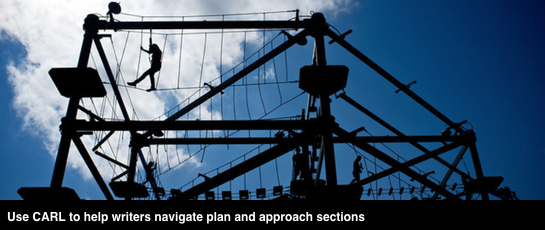Every RFP we’ve seen requires plans for how the proponent will perform various aspects of the project. Depending on the contract on offer, these could include design, construction, transition (or implementation), operation, maintenance, etc.
A compliant response will include details of actions the proponent will take, including a schedule with milestones. But a simple list of actions won’t win top marks. To impress evaluators, you need to show the thinking behind your plan, demonstrate past success and show how it aligns with the current project’s unique requirements.
This post suggests a model for structuring plans designed to attract maximum points.
Compliance first
Most RFPs use questions within each section to specify the content of a complete response. Ensure the ATOC and the proposal template include all needed subheads within each plan section to fully align with all RFP questions.
Beyond compliance
The CARL model described below (named for the first letter of four parts), aims to bring out the strategic thinking behind each plan, to show past success, and to tie the plan of action back to the specific requirements and challenges of this project.
It can be used at the section level, for subsections, or even within a paragraph.
Components and prompts for using CARL
Use the following prompts in the order shown in writing your response:
CONCEPT— At a high level, what do we aim to accomplish (i.e. objective/philosophy, goal/mission, value-add/Intention)?
- Clearly define your objective for the section or subsection.
- Cite 3–5 guiding principles and the benefit related to each (budget or schedule certainty, cost reduction, risk mitigation, safety, environmental impact, etc.).
- Use simple, engaging language; do not assume the reader understands your discipline.
ACTIONS—How will we fulfill the requirements for this section?
- Describe the actions we will take to achieve the objective.
- Cite one or more situations where our team has used this solution before.
- Explain why this approach is superior to others.
RESULTS—Where have we been successful with this solution in the past?
- Where, when and how the team has successfully executed solutions of similar scope?
- Cite tangible results (money saved, early completion, awards) and benefit to client/project
- Support claims using success stories, case studies, statistics and testimonials
LINKS—What makes this approach relevant and helpful with this specific project?
- How does this approach apply to the issuer’s key issue(s) and known technical challenges for the project?
- What aspects of past approaches will be modified/improved for this project?
- How does this approach satisfy quality/schedule/price/total cost of ownership requirements?
CARL works
Complex2Clear has used CARL successfully for plan and approach sections with many proposal teams—including on very large projects. It is especially helpful in creating a single, consistent voice where individuals from several departments (or companies) are responsible for various plans.
Our structural editors also use it to create a stronger logic flow when working with first drafts.


